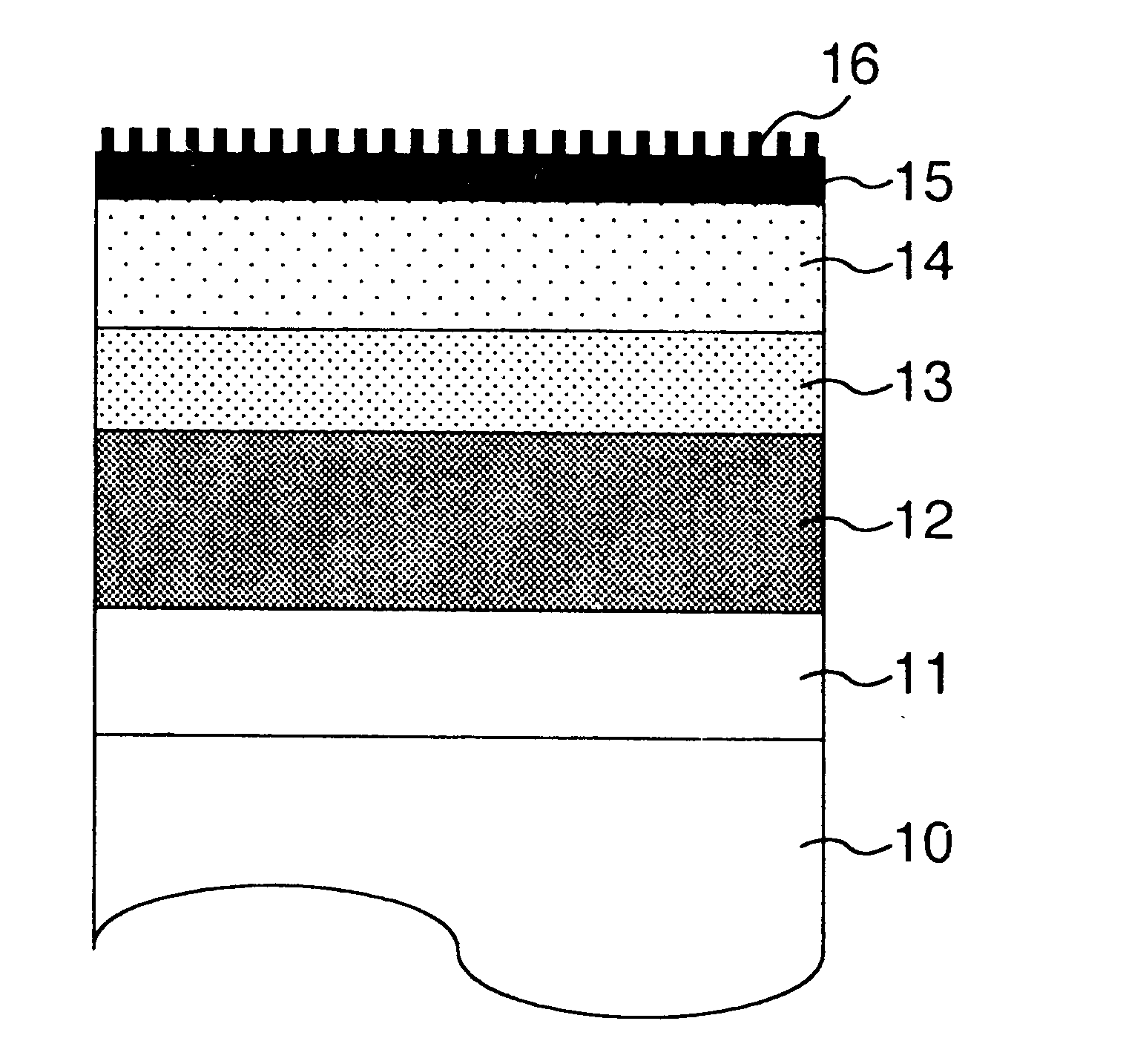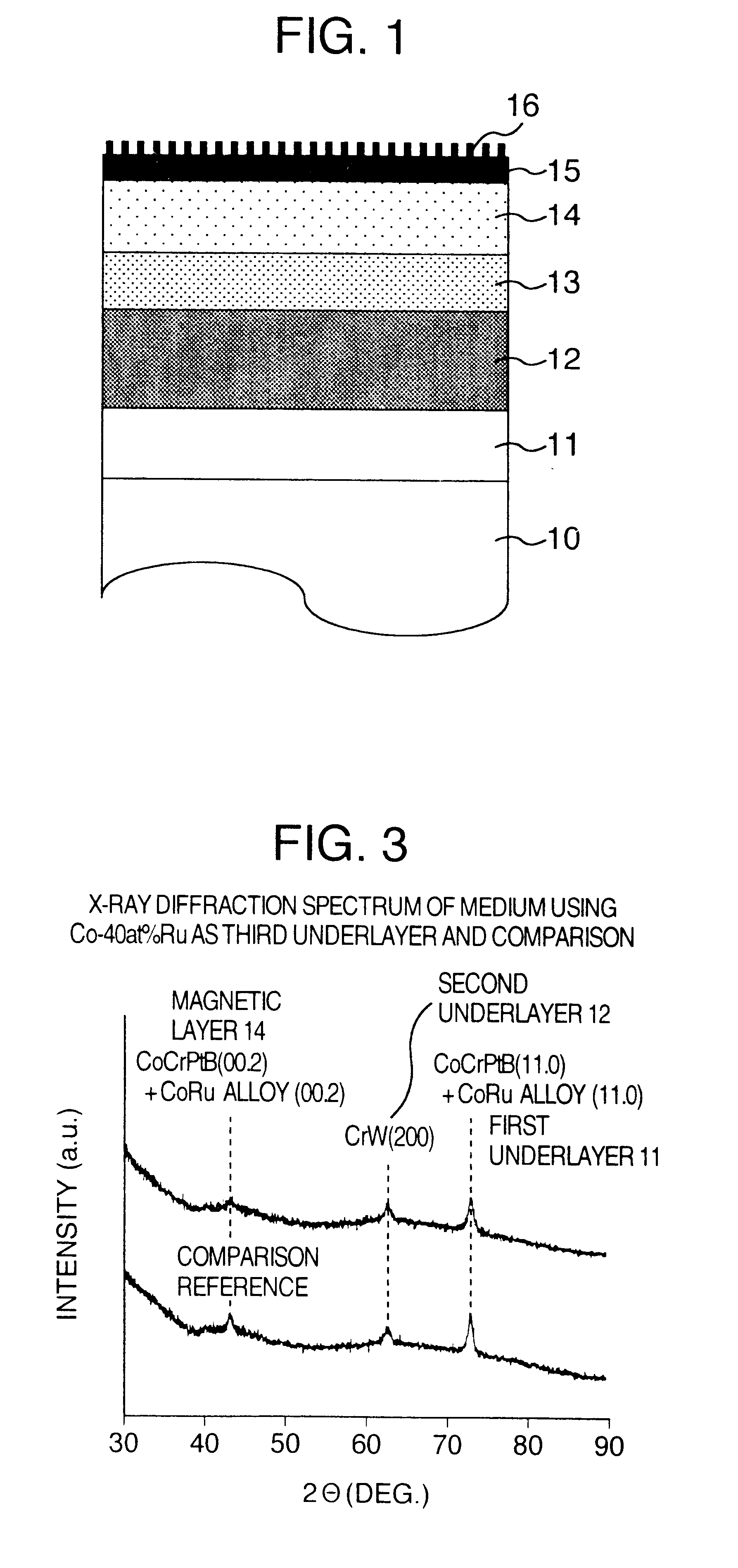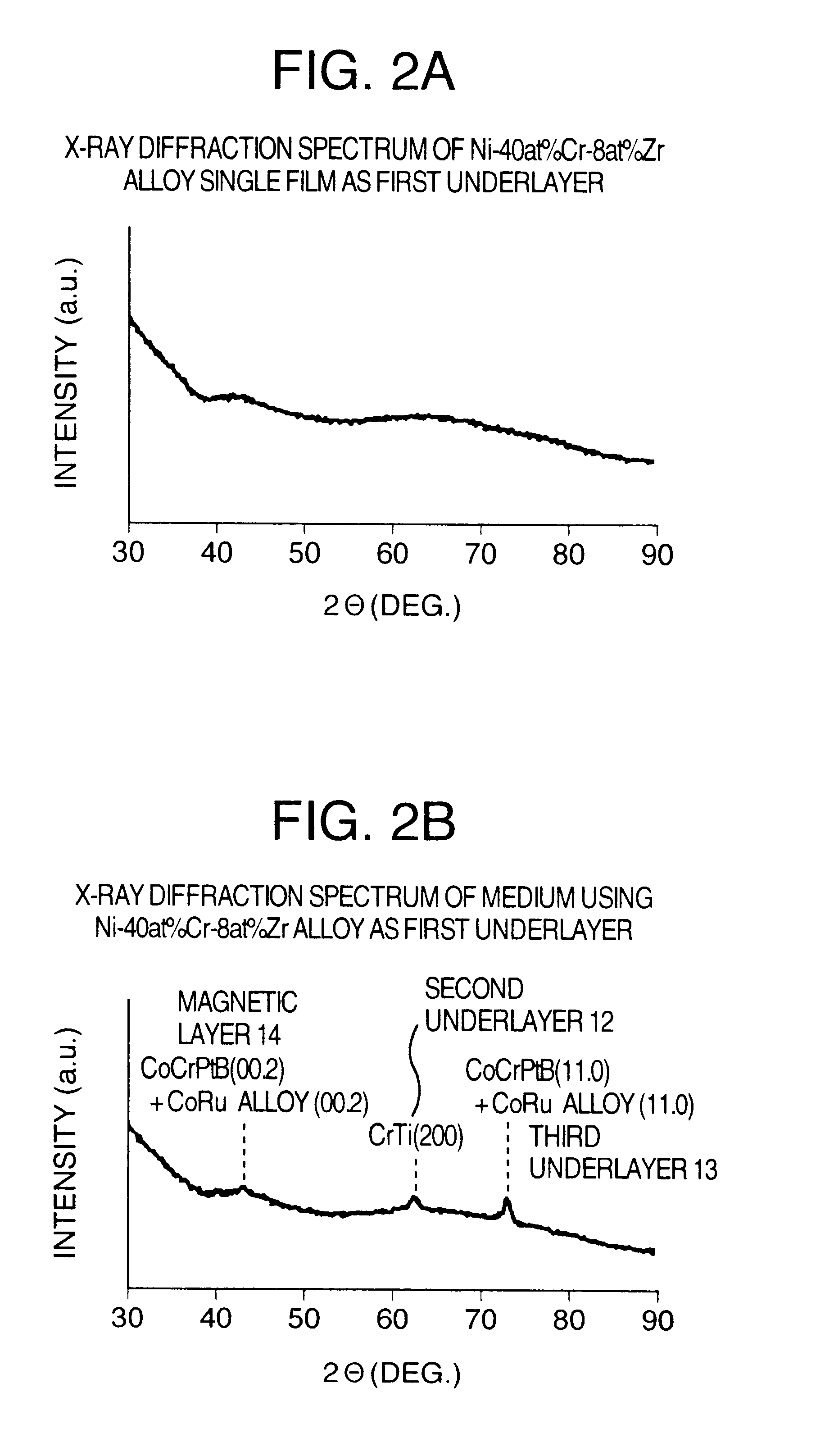Magnetic recording medium and magnetic recording apparatus
a recording medium and magnetic technology, applied in the field of longitudinal magnetic recording medium, can solve the problems of insufficient grain size, inability to implement amorphousness, and insufficient amorphousness, and achieve the effects of high recording density, high reliability, and improved durability and corrosion resistan
- Summary
- Abstract
- Description
- Claims
- Application Information
AI Technical Summary
Benefits of technology
Problems solved by technology
Method used
Image
Examples
first embodiment
A substrate composed of alumino silicate system tempered glass being 64 mm in diameter and 0.635 mm in thickness was alkali-cleaned and then dried. Then, the substrate was put into a leaf type film forming apparatus having a plurality of chambers. Next, the apparatus was shifted into a vacuum state. A first underlayer 11 was formed in the thickness of 30 nm by the DC sputtering method in an atmosphere where an argon gas pressure is 0.8 to 1.0 Pa without heating the substrate. As the first underlayer material was used a Co-32 at. % CR-6 at. % Zr, Co-32 at. % Cr-12 at. % Hf, Co-36 at. % Cr-8 at. % Ta, Co-34 at. % Cr-25 at. % W, Co-40 at. % V-6 at. % Ti, Co-40 at. % V-8 at. % B, Co-50 at. % V-12 at. % Si, Co-45 at. % Mn-20 at. % Nb, Co-45 at. % Mn-25 at. % Mo, Ni-38 at. % Ta, Ni-55 at. % W, Ni-40 at. % Cr-8 at. % Zr, Ni-40 at. % Cr-12 at. % Ti, Ni-50 at. % V-15 at. % B, Ni-55 at. % V-15 at. % Si, or Ni-38 at. % V-30 at. % Mo alloy. After forming the first underlayer 11, the substrate w...
second embodiment
An alkali-cleaned soda lime based glass substrate 10 that is 64 mm in diameter and 0.635 in thickness was heated up to 100.degree. C. and the Co-35 at. % Cr-12 at. % Zr alloy was formed as the first underlayer 11 to have a thickness of 40 nm through the effect of the film-forming apparatus described with respect to the first embodiment. The underlayer was formed by using the mixed gas having argon as its main component with an addition of a 10% oxygen and at a gas pressure of 2.7 Pa. Afterwards, the substrate was heated up to 260.degree. C. The second underlayer 12 is formed of the Cr-25 at. % W alloy to have a thickness of 30 nm and the third underlayer 13 is formed of the Co alloy to have a thickness of 5 nm. The magnetic layer 14 is then formed of a Co-22 at. % Cr-14 at. % Pt-4 at. % B to have a thickness of 14 to 20 nm, and the carbon protective film 15 is formed with 6 nm thick. Herein, the third underlayer 13 of the Co alloy was used of the Co-30 at. % Ru, Co-35 at. % Ru, Co-4...
third embodiment
The medium having the similar composition to that of the second embodiment, in which as the third underlayer 13 is used of the Co-40 at. % Ru, Co-40 at. % Ru-1 at. % B, Co-40 at. % Ru-3 at. % B, Co-40 at. % Ru-6 at. % B, Co-40 at. % Ru-12 at. % B, or Co-40 at. %Ru-15 at. % B alloy and as the magnetic layer 14 is used of the Co-18 at. % Cr-16 at. % Pt-6 at. % B alloy in the thickness of 14 nm, was manufactured by the similar film forming process to that of the second embodiment. When this medium was subject to the X-ray diffraction measurement, like the embodiment of the second embodiment, what was observed is only the (200) diffraction peak of the CrW underlayer 12 and the (11.0) diffraction peak of a mixture of the Co alloy underlayer 11 and the CoCrPtB magnetic layer 14.
The magnetic layer included in this embodiment was observed by using the high resolution transmission electron microscope. The lattice image was magnified to 2 million times and imaged. The grain sizes of about 200...
PUM
| Property | Measurement | Unit |
|---|---|---|
| grain size | aaaaa | aaaaa |
| grain size | aaaaa | aaaaa |
| crystal grain size | aaaaa | aaaaa |
Abstract
Description
Claims
Application Information
 Login to View More
Login to View More - R&D
- Intellectual Property
- Life Sciences
- Materials
- Tech Scout
- Unparalleled Data Quality
- Higher Quality Content
- 60% Fewer Hallucinations
Browse by: Latest US Patents, China's latest patents, Technical Efficacy Thesaurus, Application Domain, Technology Topic, Popular Technical Reports.
© 2025 PatSnap. All rights reserved.Legal|Privacy policy|Modern Slavery Act Transparency Statement|Sitemap|About US| Contact US: help@patsnap.com



